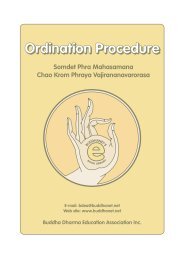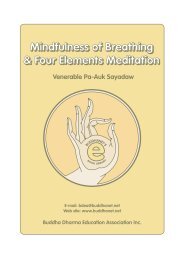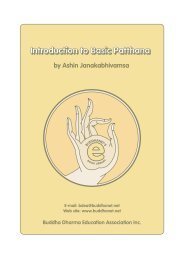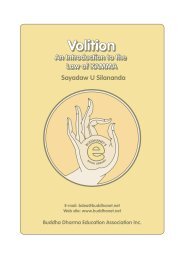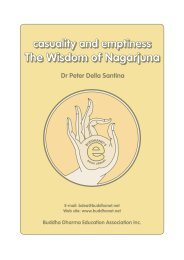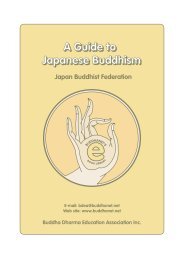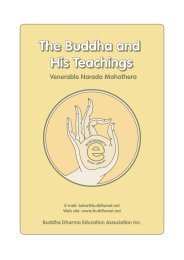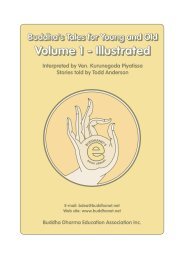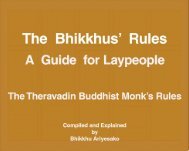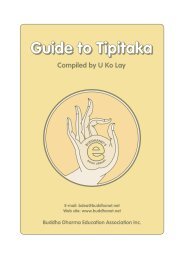No Inner Core: An Introduction to the Doctrine of Anatta - BuddhaNet
No Inner Core: An Introduction to the Doctrine of Anatta - BuddhaNet
No Inner Core: An Introduction to the Doctrine of Anatta - BuddhaNet
Create successful ePaper yourself
Turn your PDF publications into a flip-book with our unique Google optimized e-Paper software.
Direct Experience <strong>of</strong> <strong>An</strong>attà<br />
The anattà doctrine is extremely difficult <strong>to</strong> comprehend.<br />
One can speculate or ponder about it – that is<br />
one kind <strong>of</strong> knowledge, acquired by listening <strong>to</strong> a lecture<br />
or by reading. One may also ponder over it more<br />
deeply in contemplation. But one can only really penetrate<br />
in<strong>to</strong> it during Vipassanà meditation.<br />
When yogis practice, <strong>the</strong>y keep <strong>the</strong>mselves aware<br />
<strong>of</strong> everything. When <strong>the</strong>y see something, <strong>the</strong>re are two<br />
things: <strong>the</strong> mind which sees and <strong>the</strong> object seen; apart<br />
from <strong>the</strong>se, <strong>the</strong>re is nothing. More specifically, seeing<br />
is a process which depends on four things: <strong>the</strong> eye, <strong>the</strong><br />
visible object, light, and attention <strong>to</strong> <strong>the</strong> object. If one<br />
<strong>of</strong> <strong>the</strong>se conditions is lacking, no seeing occurs. If one<br />
does not have eyes, no atta can make one see. Only<br />
when all conditions are met does seeing consciousness<br />
arise. <strong>No</strong> agent like atta is a part <strong>of</strong> this.<br />
Likewise, when yogis note <strong>the</strong>mselves thinking<br />
during meditation, <strong>the</strong>y note “thinking, thinking,<br />
thinking,” and <strong>the</strong>y find only thinking and <strong>the</strong> mind<br />
which notes it – <strong>the</strong>y do not find a self or ego or atta.<br />
They do not find that “I am thinking,” unless <strong>the</strong>y add<br />
this idea as an afterthought. They really only find that<br />
thinking is occurring. In this process, yogis can see<br />
<strong>the</strong> impermanence <strong>of</strong> mind and thought: one thought<br />
comes, <strong>the</strong>n goes; ano<strong>the</strong>r thought comes and goes,<br />
and this goes on and on. A new thought comes every<br />
moment, arising and disappearing. They directly see<br />
<strong>the</strong> impermanence <strong>of</strong> thought. They can also notice<br />
40



